Dear Reader, in this age of AI created content, please support with your goodwill someone who works harder to provide the human-made. Sign up at the top of the lefthand column or bottom of this page. You will receive my hand illustrated monthly newsletter RESTORE NATURE and access to the biodiversity garden design course as I write...and nothing else, I respect your time. I am also removing the advertizing as best I can as its become intrusive inappropriate and pays me nothing.
red flowers and orange flowers in the july garden
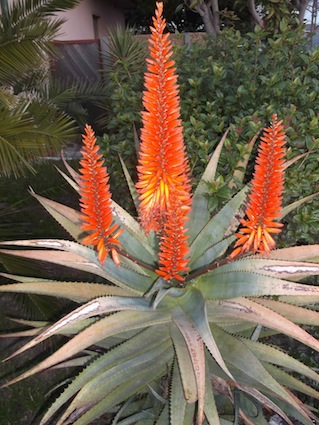
I've grouped the red flowers with orange as there is a continuum between all flower colours so that no two are identical, but this particular shift is difficult to cordon off.
the native red flowers and orange flowers are mainly succulents at the moment
The warm colours in late winter are dominated by flowering succulents, mainly a huge diversity of aloes with their spear shaped inflorescences, some borne more dispersed as a tree of bells, and then the Cotyledon with its heads of hanging bells. Most of these succulents flowering now are red to orange or pinkish. They vary in size from enormous specimens of Aloe ferox (not indigenous) to tall clumps of flaming aloes over head height, and then tiny climbing aloes.
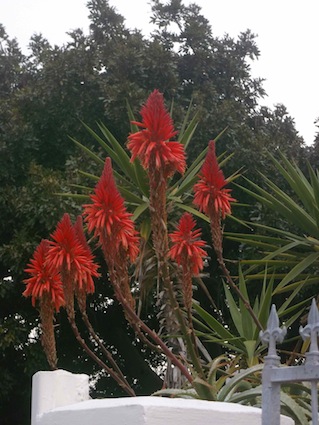
Round about this time of year bees become quite a problem because we have so many aloes and my dog has a habit of chasing and snapping at bees, they drive him crazy, and then I’m worried he’ll swallow one and his airways will swell up and choke him. But the up side is that these aloes have attracted malachite sunbirds, here in this over built up concrete jungle.
UPDATE: this year the bees have disappeared from our neighbourhood. We had to hand pollinate vegetables. I'm very concerned as to why. It may be the drought. Then they reappeared in spring after the rainy season. Its been a wet spring too.
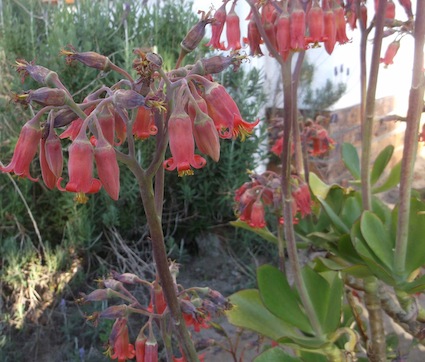
The Cotyledon are mainly smallish plants with spoon shaped leaves, or more rarely big grey needles. They all have bell flowers. Some varieties can have leaves the size of a saucer and grow to waist high shrubs. I'm not a major collector but I have about 6 kinds, there are many more.
the red flowers of hibiscus are exotic but ubiquitous
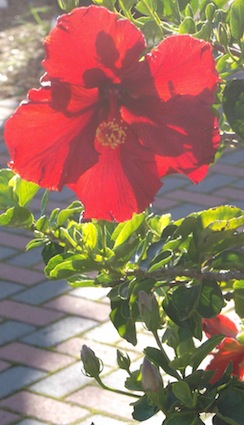
The next largest group in my area were, I found, the exotic Hibuscus, many at the tail end of their flowering season, but the deep red simple hibiscus and the frilly pink ones which are not at their fullest yet, do seem to come a bit later than the simple pale pinkish white ones which I photographed in late summer.
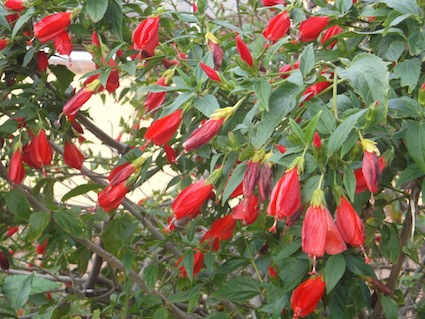 the red bell hibiscus Malvaviscus penduliflorus is a large shrub and does well here
the red bell hibiscus Malvaviscus penduliflorus is a large shrub and does well hereIn our area is also red bell hibiscus which grows to the height of a large shrub or small tree which is now at its peak. I've found them easy to root too. Just stand a forearm length twig in a glass of water on the windowsill... that simple.
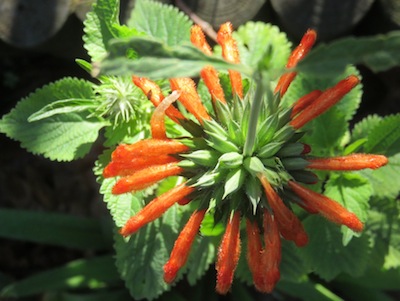 Leonotus has bright orange flowers with nectar
Leonotus has bright orange flowers with nectarThe aloes and succulents are largely indigenous, as is the Wilde dagga, or Leonotus leonorus, a large spicy smelling shrub. The Leonotus has attractive heads which are also interesting to look at when dried out on the bush. There is something about the Salvia family, I feel they are a must in every African garden, as perfumed medicinal plants which smell good in the strong sunshine, and whose flowers attract bees and nectar loving birds, as do the aloes.
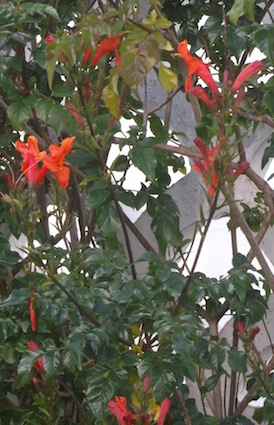 cape honey suckle, Tecoma capensis, also nectar yielding
cape honey suckle, Tecoma capensis, also nectar yieldingGrowing in our street are several of the Cape honey suckle, a shrubby sort of climber. Both this and Leonotus have bright orange flowers.
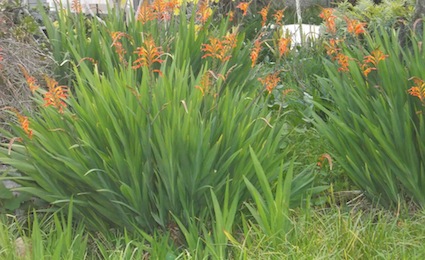 Chasmanthe floribunda, rooi afrikaner
Chasmanthe floribunda, rooi afrikanerIn our sandy area, there are indigenous Afrikaners, in massive stands growing in the long grass in a lovely rank garden on Merriman Street.
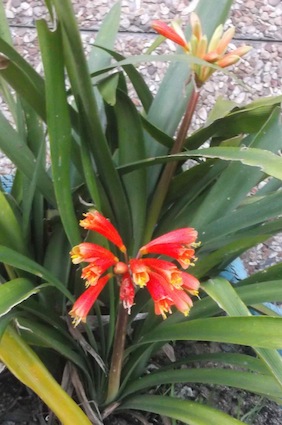
An isolated Clivia robusta ? was in a pot somewhere near there. None of my Clivias are flowering at present.
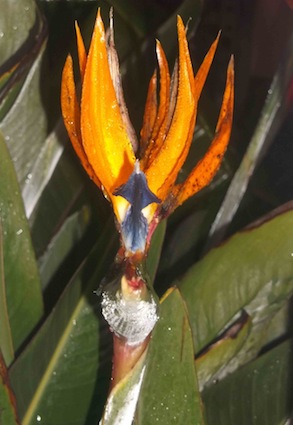 Crane flower or Strelitzia, in banana family
Crane flower or Strelitzia, in banana familyMany gardens have Crane flowers, and one has a massive majestic clump higher than head height. Orange flowers are borne by the Cape honeysuckle and the climber called Black Eyed Susan, and then there were exotic bottlebrush, Camelias, Pansies, Pointsettias, the red berries of the Brazilian pepper and then various other kinds of berries and foliage with warm colours which are also all exotics.
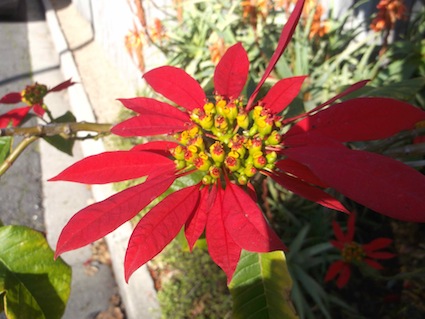 these lovely red flowers are also exotics: pointsettia
euphorbia pulcherrima
these lovely red flowers are also exotics: pointsettia
euphorbia pulcherrimaBougainvilla is beginning to flower. I don’t like it because it is rank and invasive in the garden, has got so out of hand in gardens I know and I think it is basically ugly and boring in its form, and leaf, except for its diverse colours. Its hard to work with, covered in thorns which burn for days and penetrate shoes if a branch is left on the ground.
I could not include photographs of everything on this page, but I have a photo album of red flowers on another website. To see all the colour pages on this website, go to my navigation bar and hover over 'decoratives', then move down and hover over 'colours'. You can see each individual colour .
home page for more green inspiration
You’re a home gardener ! Share your experiences and questions !
We all know about home gardening. Tell us about your successes, challenges and ask about issues that bother you. You may have the luxury of a back garden, but there are other ways we learn. Few people age without growing something or buying vegetables during their lives ! It is absolutely guaranteed that you have learned things which can help others on their gardening journey.
We invite you to share your stories, ask questions, because if a thing has bothered you it will bother others too. Someone may have a solution ! No question is too small. There is learning for everyone involved, for you, for me (yes, I learn from every question), for us all. Exciting stuff !
We are starting on a new journey. Every week we will profile your letters ! The best stories and questions we receive.
Restore Nature Newsletter
I've been writing for four years now and I would love to hear from you
Please let me know if you have any questions, comments or stories to share on gardening, permaculture, regenerative agriculture, food forests, natural gardening, do nothing gardening, observations about pests and diseases, foraging, dealing with and using weeds constructively, composting and going offgrid.
SEARCH
Order the Kindle E-book for the SPECIAL PRICE of only
Prices valid till 30.09.2023
Recent Articles
-
garden for life is a blog about saving the earth one garden at a time
Apr 18, 25 01:18 PM
The garden for life blog has short articles on gardening for biodiversity with native plants and regenerating soil for climate amelioration and nutritious food -
Cape Flats Sand Fynbos, Cape Town's most endangered native vegetation!
Apr 18, 25 10:36 AM
Cape Flats Sand Fynbos, a vegetation type found in the super diverse Cape Fynbos region is threatened by Cape Town's urban development and invasive alien plants -
Geography Research Task
Jan 31, 25 11:37 PM
To whom it may concern My name is Tanyaradzwa Madziwa and I am a matric student at Springfield Convent School. As part of our geography syllabus for this
"How to start a profitable worm business on a shoestring budget
Order a printed copy from "Amazon" at the SPECIAL PRICE of only
or a digital version from the "Kindle" store at the SPECIAL PRICE of only
Prices valid till 30.09.2023







